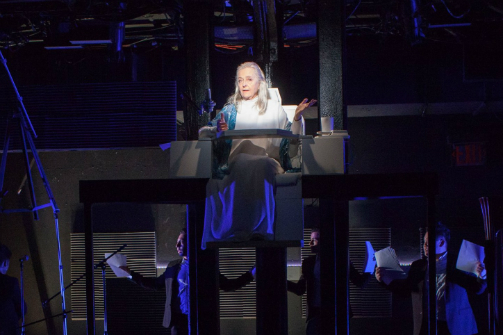
Thomas Paine In Violence
By Paul Pinto; Directed by Rick Burkhardt
Off Off Broadway, Experimental Opera
Runs through 11.18.17
HERE Arts Center, 145 Sixth Avenue
by Ran Xia on 11.13.17
 Joan La Barbara in Thomas Paine In Violence. Photo by Benjamin Heller.
Joan La Barbara in Thomas Paine In Violence. Photo by Benjamin Heller.
BOTTOM LINE: Paul Pinto's experimental opera brings founding father Thomas Paine's ideologies up to date in an explosion of sound and poetry.
You can barely make out the shape—a structure behind dazzling lights, a control tower of sorts; the silhouette inside has wispy white hair framing a slender, slightly tilted face. The music is both ancient and sci-fi, as if you’re about to encounter a tribe of extraterrestrial beings. It's as if you’re staring into the sun amidst the dark universe, until the surrounding stars are lit ablaze from a chorus of restless, unidentifiable beings. The cacophony sets the show pulsing like a living thing, taking its first fiery breaths and then waiting patiently for your eyes to adjust to the ominous dark. And at this point, a woman (Joan La Barbara) begins to speak with a precise and deliberate countenance, lamenting the word “civilization.”
Apparently, it’s “the spirit of the deceased Thomas Paine broadcasting from a radio station in space, whatever that means.” And indeed, Thom Paine’s spirit is a woman; in this, the incomparable La Barbara has a presence that’s both enigmatic and regal, her voice soothing and powerful. The chorus of men (including writer-composer Paul Pinto), each holding a blinking flashlight, lets out echoes and explosions and connections between synapses.
It’s a message, carried through time and space, from the essence of Thomas Paine. Founding father Paine, resident radical of the United States, was more than just a revered historical figure. He was something of a legend: the Englishman who became an American (in the modern sense of the word) by choice, representing the best part of the new world. Thomas Paine in Violence, set up to be a radio show hosted by La Barbara pretending to be the phantom Paine, is spoken word poetry that’s been blasted into a multidimensional soundscape with operatic volume. The language of it is accessible, something famously acknowledged in Paine’s own writing. In fact, I’m quite sure if Thomas Paine had been an actual radio show host, he wouldn’t have shied away from saying words like “fuck” or “cocksucker.” La Barbara sensors herself with a buzzer, and it sure bleeps a lot during the rapid 75-minute show.
In stark contrast to La Barbara’s stillness, the chorus of men is like a constantly boiling substance, offering contradictions and often illegible counterpoints. The voices of the four men become instrumental-like, indiscernible, like a layer of white noise, an abstract, aural presence of violence. The rhythmic chants of the chorus morph from one phrase to another; their voices swell into a crescendo and the meaning of their words become unnecessary. You are transported to a protest, any protest, where there is an uprising sustained by a profound belief.
A highly stylized and concept-driven piece such as this can have the tendency to slip into obscurity at times. Occasionally, I felt lost in a flood of information and sensory stimuli. Fortunately there are enough moments of substance that can pull one back from these distractions. The high-octane production is reminiscent of Bloody Bloody Andrew Jackson, except perhaps Thomas Paine in Violence is more stark and earnest (both in style and content). It’s not a grim show; in fact, the spirit of Thom Paine gets a lot of laughter. And her associates (the chorus and the musicians) are an assembly of peculiar individuals, each offering a unique point of view. But the show doesn’t get laughter from silliness; indeed, it's a thoughtful piece that entertains before making a lasting, more serious impression. It's also important to point out the Marie’s Crisis reference (the musical theatre mecca right next door to where Thomas Paine died).
Pinto has created an ambitious and fascinating construct that might as well have resurrected Thomas Paine. The radical thought-leader’s life began with a series of failures and ended with a series of strokes, among other diseases. Through his writing, his influence stretched far and wide. In a way, Paine is now immortal, since his ideas remain relevant in these present “trying times.” For those familiar with Paine’s writing, Pinto’s work is a recognizable tribute to the author of Common Sense and Right of Men; for those rusty on American history, the piece will kindle your interest in Paine’s political theories.
Thomas Paine once said “I prefer peace, but if trouble must come, let it come in my time, so that my children can live in peace.” In La Barbara’s voice, this version of Thomas Paine compares the violence of his illnesses at the end of his life (abscesses, gout, strokes) to the kind of violence a civilization might experience: oppression, poverty, the kind of violence not readily visible, but destructive all the same. And there’s the violence of charity, since it gnarls away dignity and has inequality as a prerequisite. In 21st-century America, where poverty has become an insatiable monster that swallows more people every year, Paine’s centuries-old ideas are alarmingly relevant. The voice from space continues to plead, not for charity but for justice, not for charity but for rights.
(Thomas Paine In Violence plays at HERE Arts Center, 145 Sixth Avenue, through November 18, 2017. The running time is 75 minutes with no intermission. Performances are Wednesdays through Saturdays at 8:30. Tickets are $25 – $45 and are available at here.org or by calling 212-352-3101.)
Thomas Paine In Violence is by Paul Pinto. Directed by Rick Burkhardt. Choreography by Chloe Treat. Set Design by Carolyn Mraz. Lighting Design by Jeanette Oi-Suk Yew. Sound Design by Philip White. Production Stage Manager is Alex B. West.
The cast is Joan La Barbara, Christian Luu, Andrew Mayer, Paul Pinto, and Eddie Rodriguez. Musicians are Mélanie Genin, Andrew Livingston, Erin Rogers, and Jeffrey Young.

